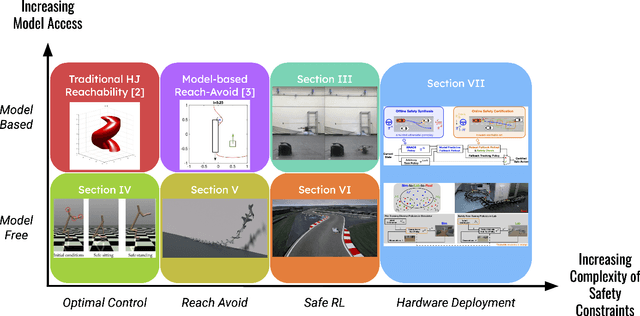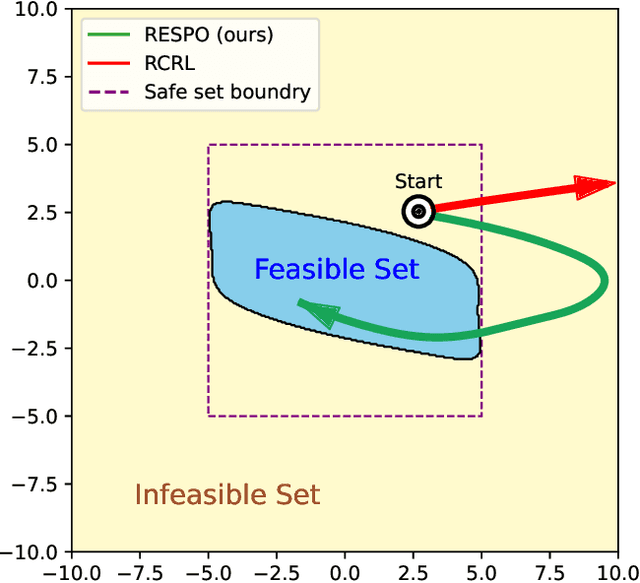Sylvia Herbert
MADR: MPC-guided Adversarial DeepReach
Oct 21, 2025Abstract:Hamilton-Jacobi (HJ) Reachability offers a framework for generating safe value functions and policies in the face of adversarial disturbance, but is limited by the curse of dimensionality. Physics-informed deep learning is able to overcome this infeasibility, but itself suffers from slow and inaccurate convergence, primarily due to weak PDE gradients and the complexity of self-supervised learning. A few works, recently, have demonstrated that enriching the self-supervision process with regular supervision (based on the nature of the optimal control problem), greatly accelerates convergence and solution quality, however, these have been limited to single player problems and simple games. In this work, we introduce MADR: MPC-guided Adversarial DeepReach, a general framework to robustly approximate the two-player, zero-sum differential game value function. In doing so, MADR yields the corresponding optimal strategies for both players in zero-sum games as well as safe policies for worst-case robustness. We test MADR on a multitude of high-dimensional simulated and real robotic agents with varying dynamics and games, finding that our approach significantly out-performs state-of-the-art baselines in simulation and produces impressive results in hardware.
Reachability Barrier Networks: Learning Hamilton-Jacobi Solutions for Smooth and Flexible Control Barrier Functions
May 16, 2025Abstract:Recent developments in autonomous driving and robotics underscore the necessity of safety-critical controllers. Control barrier functions (CBFs) are a popular method for appending safety guarantees to a general control framework, but they are notoriously difficult to generate beyond low dimensions. Existing methods often yield non-differentiable or inaccurate approximations that lack integrity, and thus fail to ensure safety. In this work, we use physics-informed neural networks (PINNs) to generate smooth approximations of CBFs by computing Hamilton-Jacobi (HJ) optimal control solutions. These reachability barrier networks (RBNs) avoid traditional dimensionality constraints and support the tuning of their conservativeness post-training through a parameterized discount term. To ensure robustness of the discounted solutions, we leverage conformal prediction methods to derive probabilistic safety guarantees for RBNs. We demonstrate that RBNs are highly accurate in low dimensions, and safer than the standard neural CBF approach in high dimensions. Namely, we showcase the RBNs in a 9D multi-vehicle collision avoidance problem where it empirically proves to be 5.5x safer and 1.9x less conservative than the neural CBFs, offering a promising method to synthesize CBFs for general nonlinear autonomous systems.
Reach-Avoid-Stabilize Using Admissible Control Sets
May 14, 2025Abstract:Hamilton-Jacobi Reachability (HJR) analysis has been successfully used in many robotics and control tasks, and is especially effective in computing reach-avoid sets and control laws that enable an agent to reach a goal while satisfying state constraints. However, the original HJR formulation provides no guarantees of safety after a) the prescribed time horizon, or b) goal satisfaction. The reach-avoid-stabilize (RAS) problem has therefore gained a lot of focus: find the set of initial states (the RAS set), such that the trajectory can reach the target, and stabilize to some point of interest (POI) while avoiding obstacles. Solving RAS problems using HJR usually requires defining a new value function, whose zero sub-level set is the RAS set. The existing methods do not consider the problem when there are a series of targets to reach and/or obstacles to avoid. We propose a method that uses the idea of admissible control sets; we guarantee that the system will reach each target while avoiding obstacles as prescribed by the given time series. Moreover, we guarantee that the trajectory ultimately stabilizes to the POI. The proposed method provides an under-approximation of the RAS set, guaranteeing safety. Numerical examples are provided to validate the theory.
Solving Reach- and Stabilize-Avoid Problems Using Discounted Reachability
May 14, 2025Abstract:In this article, we consider the infinite-horizon reach-avoid (RA) and stabilize-avoid (SA) zero-sum game problems for general nonlinear continuous-time systems, where the goal is to find the set of states that can be controlled to reach or stabilize to a target set, without violating constraints even under the worst-case disturbance. Based on the Hamilton-Jacobi reachability method, we address the RA problem by designing a new Lipschitz continuous RA value function, whose zero sublevel set exactly characterizes the RA set. We establish that the associated Bellman backup operator is contractive and that the RA value function is the unique viscosity solution of a Hamilton-Jacobi variational inequality. Finally, we develop a two-step framework for the SA problem by integrating our RA strategies with a recently proposed Robust Control Lyapunov-Value Function, thereby ensuring both target reachability and long-term stability. We numerically verify our RA and SA frameworks on a 3D Dubins car system to demonstrate the efficacy of the proposed approach.
Back to Base: Towards Hands-Off Learning via Safe Resets with Reach-Avoid Safety Filters
Jan 05, 2025Abstract:Designing controllers that accomplish tasks while guaranteeing safety constraints remains a significant challenge. We often want an agent to perform well in a nominal task, such as environment exploration, while ensuring it can avoid unsafe states and return to a desired target by a specific time. In particular we are motivated by the setting of safe, efficient, hands-off training for reinforcement learning in the real world. By enabling a robot to safely and autonomously reset to a desired region (e.g., charging stations) without human intervention, we can enhance efficiency and facilitate training. Safety filters, such as those based on control barrier functions, decouple safety from nominal control objectives and rigorously guarantee safety. Despite their success, constructing these functions for general nonlinear systems with control constraints and system uncertainties remains an open problem. This paper introduces a safety filter obtained from the value function associated with the reach-avoid problem. The proposed safety filter minimally modifies the nominal controller while avoiding unsafe regions and guiding the system back to the desired target set. By preserving policy performance while allowing safe resetting, we enable efficient hands-off reinforcement learning and advance the feasibility of safe training for real world robots. We demonstrate our approach using a modified version of soft actor-critic to safely train a swing-up task on a modified cartpole stabilization problem.
Hamilton-Jacobi Reachability in Reinforcement Learning: A Survey
Jul 12, 2024



Abstract:Recent literature has proposed approaches that learn control policies with high performance while maintaining safety guarantees. Synthesizing Hamilton-Jacobi (HJ) reachable sets has become an effective tool for verifying safety and supervising the training of reinforcement learning-based control policies for complex, high-dimensional systems. Previously, HJ reachability was limited to verifying low-dimensional dynamical systems -- this is because the computational complexity of the dynamic programming approach it relied on grows exponentially with the number of system states. To address this limitation, in recent years, there have been methods that compute the reachability value function simultaneously with learning control policies to scale HJ reachability analysis while still maintaining a reliable estimate of the true reachable set. These HJ reachability approximations are used to improve the safety, and even reward performance, of learned control policies and can solve challenging tasks such as those with dynamic obstacles and/or with lidar-based or vision-based observations. In this survey paper, we review the recent developments in the field of HJ reachability estimation in reinforcement learning that would provide a foundational basis for further research into reliability in high-dimensional systems.
Mollification Effects of Policy Gradient Methods
May 28, 2024Abstract:Policy gradient methods have enabled deep reinforcement learning (RL) to approach challenging continuous control problems, even when the underlying systems involve highly nonlinear dynamics that generate complex non-smooth optimization landscapes. We develop a rigorous framework for understanding how policy gradient methods mollify non-smooth optimization landscapes to enable effective policy search, as well as the downside of it: while making the objective function smoother and easier to optimize, the stochastic objective deviates further from the original problem. We demonstrate the equivalence between policy gradient methods and solving backward heat equations. Following the ill-posedness of backward heat equations from PDE theory, we present a fundamental challenge to the use of policy gradient under stochasticity. Moreover, we make the connection between this limitation and the uncertainty principle in harmonic analysis to understand the effects of exploration with stochastic policies in RL. We also provide experimental results to illustrate both the positive and negative aspects of mollification effects in practice.
Sensor-Based Distributionally Robust Control for Safe Robot Navigation in Dynamic Environments
May 28, 2024Abstract:We introduce a novel method for safe mobile robot navigation in dynamic, unknown environments, utilizing onboard sensing to impose safety constraints without the need for accurate map reconstruction. Traditional methods typically rely on detailed map information to synthesize safe stabilizing controls for mobile robots, which can be computationally demanding and less effective, particularly in dynamic operational conditions. By leveraging recent advances in distributionally robust optimization, we develop a distributionally robust control barrier function (DR-CBF) constraint that directly processes range sensor data to impose safety constraints. Coupling this with a control Lyapunov function (CLF) for path tracking, we demonstrate that our CLF-DR-CBF control synthesis method achieves safe, efficient, and robust navigation in uncertain dynamic environments. We demonstrate the effectiveness of our approach in simulated and real autonomous robot navigation experiments, marking a substantial advancement in real-time safety guarantees for mobile robots.
JIGGLE: An Active Sensing Framework for Boundary Parameters Estimation in Deformable Surgical Environments
May 16, 2024Abstract:Surgical automation can improve the accessibility and consistency of life saving procedures. Most surgeries require separating layers of tissue to access the surgical site, and suturing to reattach incisions. These tasks involve deformable manipulation to safely identify and alter tissue attachment (boundary) topology. Due to poor visual acuity and frequent occlusions, surgeons tend to carefully manipulate the tissue in ways that enable inference of the tissue's attachment points without causing unsafe tearing. In a similar fashion, we propose JIGGLE, a framework for estimation and interactive sensing of unknown boundary parameters in deformable surgical environments. This framework has two key components: (1) a probabilistic estimation to identify the current attachment points, achieved by integrating a differentiable soft-body simulator with an extended Kalman filter (EKF), and (2) an optimization-based active control pipeline that generates actions to maximize information gain of the tissue attachments, while simultaneously minimizing safety costs. The robustness of our estimation approach is demonstrated through experiments with real animal tissue, where we infer sutured attachment points using stereo endoscope observations. We also demonstrate the capabilities of our method in handling complex topological changes such as cutting and suturing.
Parameterized Fast and Safe Tracking (FaSTrack) using Deepreach
Apr 11, 2024Abstract:Fast and Safe Tracking (FaSTrack) is a modular framework that provides safety guarantees while planning and executing trajectories in real time via value functions of Hamilton-Jacobi (HJ) reachability. These value functions are computed through dynamic programming, which is notorious for being computationally inefficient. Moreover, the resulting trajectory does not adapt online to the environment, such as sudden disturbances or obstacles. DeepReach is a scalable deep learning method to HJ reachability that allows parameterization of states, which opens up possibilities for online adaptation to various controls and disturbances. In this paper, we propose Parametric FaSTrack, which uses DeepReach to approximate a value function that parameterizes the control bounds of the planning model. The new framework can smoothly trade off between the navigation speed and the tracking error (therefore maneuverability) while guaranteeing obstacle avoidance in a priori unknown environments. We demonstrate our method through two examples and a benchmark comparison with existing methods, showing the safety, efficiency, and faster solution times of the framework.
 Add to Chrome
Add to Chrome Add to Firefox
Add to Firefox Add to Edge
Add to Edge